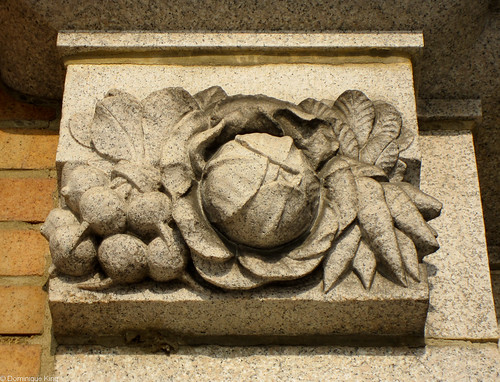Search
Disclosure
- We often travel on our own time and own dime. When we receive complimentary products, services, or accommodations as a result of our blogging activities, we will disclose that at the time we write about it. Midwest Guest is a member of ad affiliate programs and networks. If you click through the affiliate links or ads from here and purchase something from one of our affiliate partners, we receive a small commission. This income helps us pay for our blogging expenses and Midwest travel.
Categories
- Ann Arbor
- Architecture
- Art
- Back in the Saddle
- Baseball
- Bed & Breakfast
- Books
- Bridges
- Canada
- Chicago
- classic cars
- Clawson
- Connecticut
- Dearborn
- Detroit
- Discovering Ohio
- Film
- Food and Drink
- France
- Games
- Gardens
- geocaching
- History
- Hockey
- Holiday
- Illinois
- Indiana
- Iowa
- Kansas
- Kentucky
- Lighthouse
- Literature
- lodging
- Massachusetts
- Michigan
- Midwest Market Basket
- Minnesota
- Missouri
- Motorcycling
- museum
- Music
- My Guest Posts
- Nebraska
- North Dakota
- Ohio
- Oklahoma
- Parks
- Passports with Purpose
- Pennsylvania
- Photography
- Religion
- Rhode Island
- Science
- Shopping
- South Dakota
- Spain
- Sports
- Television
- Tennessee
- Toledo
- Travel
- Travelblogging
- Traverse City
- Urbane Life
- Waterfalls
- West Virginia
- Where I live
- Where's George
- Wisconsin
- Wyoming
Featured at
Blogroll
- Cindy LaFerle's Home Office
- The Night Train
- The Wandering Photographer
« October 2013 | Main | December 2013 »
November 2013
November 28, 2013
Happy Thanksgiving!
Recommended reading
Posted at 03:00 AM in Holiday, Ohio, Travel | Permalink | Comments (0) | TrackBack (0)
|
| |
November 26, 2013
Passports with Purpose 2013 kickoff
We happily anticipate spending Thursday enjoying a day of thanks and celebration with our families here in the States on Thanksgiving, so I find it particularly appropriate that today the travel blogging community celebrates the launch of our sixth annual Passports with Purpose charitable fundraising drive to assist buildOn in an effort to construct three primary schools and fund three Adult Literacy programs in the Sikasso region of Mali, Africa.
The goal is, again, admittedly ambitious--to raise $115,000 in the space of two weeks to support buildOn's effort to help give the gift of reading to others, but I know we'll be able to do it!
The travel blogging community certainly doesn't think small, but the group banded together to build a solid track record of raising money for various worthy charities around the globe.
I remember the first Passports with Purpose launch in 2008, when a small group of bloggers asked the rest of us to join them in achieving what I thought was a pretty ambitious goal at the time--to raise $5,000 to benefit charity as a way to express our gratitude for the joy we find in traveling and to give back to the wider world that played host to our wanderlust.
That year, a hastily organized drive met and surpassed that goal as the group raised $7,400 to benefit Heifer International.
Bloggers and sponsors continued working together in the following years as the goals became more ambitious and the fundraising group became better known within the travel blogging community, as well as the larger travel and social media communities.
In 2009, Passports with Purpose rallied again to raise $28,000 to benefit American Assistance for rural Cambodia in their efforts to build schools in that county's rural regions.
Passports with Purpose's third annual drive in 2010 raised $60,000 to support Land for Tillers Freedom to build an entire village to house 25 families in Southern India.
The year 2011 saw Passports with Purpose raising $90,000 to help Room to Read build two libraries in Zambia.
In 2012, Passports with Purpose raised $116,000 to support Water.org and its efforts to build five wells in Haiti.
How do we accomplish these grand goals?
Passports with Purpose bloggers ask their readers and friends to donate $10 to enter into a drawing for the prize of their choice from a great list of prizes furnished by bloggers and their sponsors.
The prize list in past years included the chance to experience many different travel opportunities, so I'm excited to see what this year's crop of prizes includes.
Want to check it out for yourself? The prize list went live at 11:59 p.m. EST late last night (November 25), and the fund raising drive ends a scant two weeks later at 11:59 p.m. EST on December 9.
Random draws among eligible entries for each prize determine the winners for each prize.
Passports with Purpose will notify prize winners on December 16, 2013.
Want to enter more than one drawing? No problem! For each $10 donation you make between now and December 9, Passports with Purpose enters you into the drawing for a prize of your choice. Note as you bid for prizes that shipping restrictions, terms, and blackout dates might apply in some cases.
All funds raised (minus transaction fees charged by Paypal and some small administration fees) go to our 2013 charity, buildOn.
The quality of the chosen charities we support each year, and the good work we're able to support around the globe, continues to impress and gratify me.
I always use the Charity Navigator site to check out groups I want to support, and it's also my practice to check out Passports with Purpose's chosen charities each year with this tool. Charity Navigator rates charities based on their accountability and transparency, and I was pleased to see that the chosen charity for the 2013 Passports with Purpose drive, buildOn, scored a four-star rating and high marks for the group's overhead-to-program ratio. BuildOn's own Web site also contains details about their financials.
I'm especially excited and honored to join Passports with Purpose to help spread the word as we embark on our sixth annual fund raising drive this holiday season.
Continue to follow me @midwestguest on Twitter and on my Facebook and Google+ pages for periodic updates, pointers to special prizes on the list and reminders about our Passports with Purpose fund raising drive.
© Dominique King 2013 All right reserved
Posted at 03:00 AM in Passports with Purpose, Travel, Travelblogging | Permalink | Comments (0) | TrackBack (0)
|
| |
November 21, 2013
Discover the "football capital of the world" at Discovering Ohio
Where is the "football capital of the world"?
It's in Ada, Ohio, of course!
Who knew?
Occasionally, Tim and I will decide to take a last-minute trip and hop on the Web to see what looks interesting. We ended up one weekend in Ada, Ohio after I wandered on the Web and found a nice looking inn on the campus of Ohio Northern University.
We had little idea of what to expect, but we always like visiting college towns, so we decided to make the trip.
We discovered that this little college town in northwestern Ohio also lays claim to being the "football capital of the world".

Read my latest story at the Ohio Tourism Division's Discovering Ohio blog, Visiting "the football capital of the world" - Ada, Ohio, to find out all about Ada, the campus and the "capital".
© Dominique King 2013 All rights reserved
Posted at 03:00 AM in Discovering Ohio, Ohio, Sports, Travel | Permalink | Comments (0) | TrackBack (0)
|
| |
November 19, 2013
Midwest music mix list #8: Michigan, Volume 2
The Midwest music mix list is back after a bit of a hiatus. Michigan has such a rich musical history and active current scene that I had more than enough material to put together a second list of music from and about the Mitten State:
- Dancing in the Street-is one of Motown's most celebrated and most discussed songs. This tune, first recorded by Martha and the Vandellas in 1964, originated when producer Mickey Stevenson spotted some people playing in water spraying from a Detroit fire hydrant. Stevenson wrote the song with Marvin Gaye and producer/songwriter Ivy Jo Hunter, plus Vandellas lead singer Martha Reeves added a few lyrics of her own. The song was a huge hit. Over the years, many people said the song was a 1960s civil rights anthem or call to riot. Reeves said that the song was a party song--nothing more. Still, at least one book claims the song had a much larger meaning than Reeves said it did. David Bowie and Mick Jagger and Van Halen did particularly well known covers of the song.
Martha Reeves celebrates her birthday at the 2011 Concert of Colors - Like a Rock-Detroit icon Bob Seger began his musical career in the early 1960s, becoming a regional favorite before hitting national success in the 1970s. Seger particularly appealed to his working-class fans, who saw him as one of their own. Seger refused to sell his music for use in advertisements until he allowed the use of "Like a Rock" for a long-running Chevrolet ad campaign after a chance encounter with a Detroit auto worker who urged him to lend his music to the ad to help Detroit's struggling automotive industry in the late 1980s. Seger earned a spot in the Rock and Roll Hall of Fame in 2004 and continues to spend much of his time in his metro Detroit home.
- Lose Yourself-I remember the buzz around the Super Bowl ad featuring Eminem for Chrysler when people first saw it in 2011. Eminem was very selective about licensing his music for advertising, although he occasionally did so. He was particularly selective about seeing this semi-autobiographical tune an ad, turning down many requests and millions of dollars for it. When Chrysler came to him with an idea for a two-minute ad showcasing its product, and maybe more importantly to Em, Detroit itself, he agreed to not only let them use the music. He also agreed to appear in the ad. The visuals electrified me when I first saw the ad, and the ad still resonates with me to this day. Forget Eminem's edgy persona, problematic personal relationships and brushes with the law...this ad showed the rapper and his true soul mate, the city of Detroit, as proud entities that would face their problems head on and eventually prevail. "This is the Motor City, and this is what we do", indeed.
- Dearlerships-One of the things I really enjoy about doing these Midwest Music Mix Lists is the opportunity to discover new (to me at least) music when some of my readers suggest bands for me to check out. Frontier Ruckus, a band with a strong folk/country rock vibe, released its first EP in 2006. The group released several more albums since that time, including its latest, Eternity of Dimming in 2012. The group is not especially easy to describe, but they take a crack at it themselves on their Facebook page by describing themselves as "a dealership of sorts". The group's biography on its recording label's site says that the band "celebrates and insulates itself within a world that is obsessively suburban...". Maybe it's just best to explore their catalog for yourself. Thanks to @Jetzcom for making this suggestion via Twitter.
- Petoskey Stone-This melodic ode about Michigan's State Stone, which is actually a fossil, put me in mind of sunny days along the Lake Michigan shore searching for Petoskey stones. This song comes from Dana Falconberry's 2012 album, Leelanau, which also includes other Michigan-centric titles like Sleeping Bear, Pictured Rocks, Muskegon and Tahquamenon. Although Falconberry now lives in Austin, Texas, she grew up in Michigan and still spends a lot of time on the Leelanau Peninsula in northern Michigan where she draw inspiration from northern Michigan gems like Gwen Frostic! Thanks for @hpywoman for this suggestion, again via Twitter.
- Heroic Dose-You may know Jason Newsted as a former member of Metallica, but more than a decade after parting with that group, he's still loudly and proudly making music. The Battle Creek, Michigan native recently released an album called, appropriately enough, "Heavy Metal Music". He also recalled his role in co-writing the Metallica song "Blackened" on "...And Justice for All" in the October issue of Guitar World magazine.
Be sure to check out previous posts in this series that include music mix lists for Michigan, Ohio, Minnesota, Indiana, North Dakota, Illinois, and Wisconsin.
© Dominique King 2013 All rights reserved
Posted at 03:00 AM in Michigan, Music, Travel | Permalink | Comments (0) | TrackBack (0)
|
| |
November 14, 2013
Henry County Courthouse in Napoleon, Ohio
For some reason, whenever I drive through Napoleon, Ohio, a heavy rain seems to be falling. I've admired the courthouse in the center of town, but the rain wouldn't cooperate by letting up long enough for me to stop and take a few photos of the beautiful 1880s building.
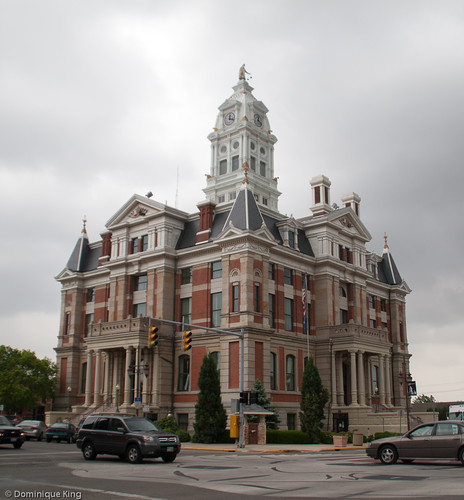
The afternoon we last drove through town was no different, but I was determined to finally get at least a few images of the Henry County Courthouse in downtown Napoleon.
I keep a two-gallon plastic zipper-close bag in my camera bag, so I had something to keep my camera dry with me during our most recent pass through Napoleon as we returned home from a visit to Sauder Village.
I got soaked, but I got a few images and my camera stayed dry!
Napoleon is about 40 miles southwest of Toledo in northwestern Ohio and is a namesake for Revolutionary-era patriot Patrick Henry, the orator best known for the phrase "give me liberty or give me death".
The area drew many new settlers during the 1820s and 1830s with the clearing of the Great Black Swamp and construction of Ohio's network of canals.
Henry County's first courthouse was a log cabin built in 1832, but court began meeting in a nearby tavern's dining room by 1834.
The second courthouse was a two-story cabin erected near the current courthouse site in 1844 by Michael Shurman for $2,000. A fire destroyed the building and all court records in 1847.

County officials approved the building of a brick, Federal-style courthouse in 1849 and saw it completed at a cost of $7,495 in 1850. The building had an impressive entrance with white pillars and a bell tower.
Fire again struck Napoleon in 1879 and almost leveled the town, destroying over 20 buildings that included the brick courthouse.
The county engaged architect David W. Gibbs of Toledo to design a new courthouse and laid a cornerstone for the project in 1880.
Gibbs presented plans for a four-story building with four square corner towers capped with finials. A 15-foot-tall statue of Lady Justice stood atop a central clock tower.
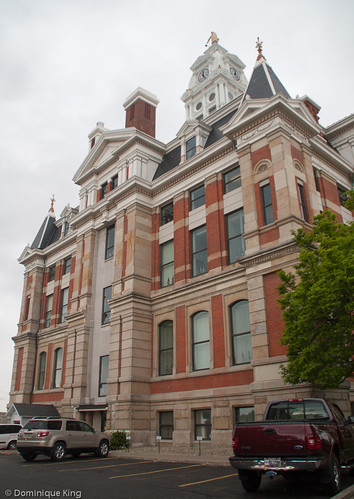
The Second Empire-style courthouse, made with limestone and locally made brick, also featured mansard roofs and cost $95,000.
The courthouse and a two-and-a-half story jail and sheriff's residence around the corner, done in a similar architectural style for $20,000, opened for business in 1882.
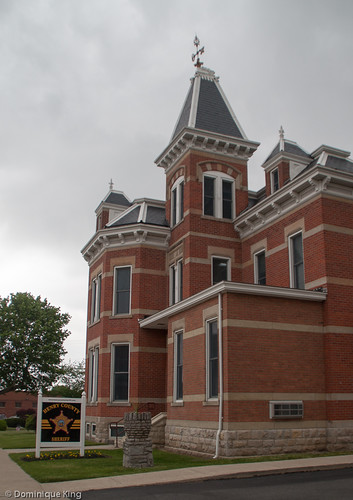
The county courthouse earned a spot on the National Register of Historic Places in 1973. The County Sheriff's Residence and Jail got on the register in 1981.
In the 1990s, county voters agreed to fund repairs and restoration of the courthouse with a four-million-dollar bond issue. The 1998 restoration and renovation also included modernizing the courthouse by adding air conditioning and new computer equipment.
I took as many photos as I could of the courthouse complex during our last visit by briefly pulling my camera out of its protective two-gallon plastic bag, tucking it back into the bag and running to a different vantage point and repeating that process several times.
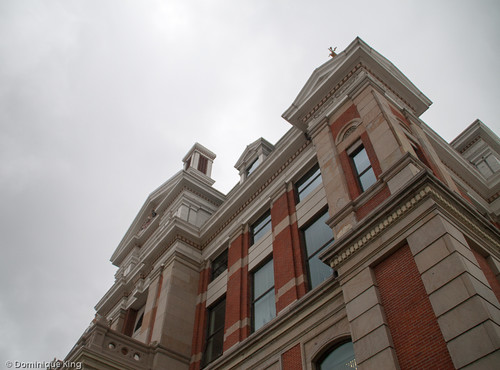
As much as my brief glimpses of the Henry County Courthouse fueled my desire to return to take photos during better weather and at a more leisurely pace, what I later learned about architect David Gibbs and his career makes me even more excited to see more of his work.
Civil War veteran Gibbs designed a number of courthouses in Ohio. His Union County Courthouse, just north west of the city of Columbus, is a near twin to the Henry County Courthouse.
Other Gibbs-designed Ohio courthouses with plans strikingly similar to the Henry and Union County courthouses include courthouses for the counties of Marion, Butler and Fayette.
Gibbs also drew up the design and specs for the Wyoming State Capitol building in 1886. That building in downtown Cheyenne has some similarities to Gibbs' Ohio courthouse designs. Wyoming's capitol building, completed in 1890, earned its spot on the National Register of Historic Places in 1987.
I next traced Gibbs to Oklahoma City where he operated an ice cream parlor.
He and his family were very active in the city's civic life. His wife served as president of the Ladies' Relief Club raising money for the needy, and his daughter often entertained townspeople by playing the city's first piano in her father's ice cream store.
Gibbs served as chairman of a board of trustees who helped set up the Oklahoma City statutory government in 1890 and became one of the city's first real mayors for a short time.
Gibbs returned to Toledo, Ohio after his wife's death in 1912 to live with his daughter. He died there in 1917, and his grave is at Toledo's historic Woodlawn Cemetery.
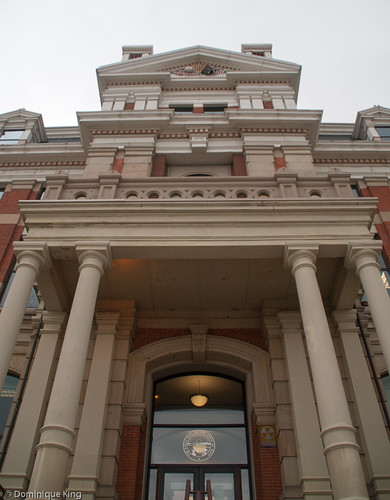
Want to learn more about Ohio's historic county courthouses? Check out County Courthouses of Ohio by Susan W. Thrane.
Your local hardware or grocery store doesn't carry the 2-gallon plastic bags? I found them on Amazon.
© Dominique King 2013 All rights reserved
Posted at 03:00 AM in Architecture, History, Ohio, Oklahoma, Travel, Wyoming | Permalink | Comments (0) | TrackBack (0)
|
| |
November 12, 2013
The Last Indian in Grand Rapids, Ohio
I spotted a head stone sitting by itself as I took some pictures of an ornate white-painted iron fence around a family cemetery along the main road through Grand Rapids, Ohio.

The cemetery, a small log cabin and a couple of historical markers were enough to pull off of the road as we passed through this small restored canal town just southwest of Toledo, Ohio even as a steady rain fell.
We love old-school two-lane highways that roll through the small towns and villages that grew up alongside them in the days before expressways and turnpikes.
So it wasn't unusual for us to find ourselves in Ohio's Grand Rapids as we returned home from visiting Sauder Village in Archbold, Ohio.
Grand Rapids and Archbold are in an area once covered by the 1,500-square-mile Great Black Swamp, a once-forbidding terrain in what is now Ohio's northwestern corner and the northeastern corner of Indiana.
Native Americans lived and hunted in the swamp near Grand Rapids until European settlers arrived to drain and farm the land twenty to thirty years after Ohio became a state in 1803.

Thomas Howard, a Revolutionary War veteran and surveyor in New York State, came here in 1822. Howard traveled by boat across Lake Erie to this spot by the head of rapids along the southern bank of the Maumee River, becoming the first white settler at the area. Howard's wife followed with the couple's three sons and their families, many of them walking through the woods of Pennsylvania and Ohio to join the family's patriarch.
In 1833, settlers platted the town of Gilead, which later became Grand Rapids.
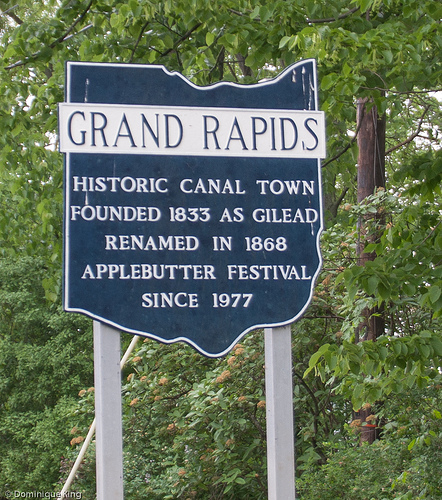
The 1830s saw the major development of Ohio's canal system. The state built a feeder from the main Miami and Erie Canal route to service Gilead when the town's residents complained about the main route following the northern bank of the Maumee near the community of Providence.
Providence overshadowed Gilead through the early 1800s, but Gilead grew and thrived as Providence had more trouble surviving in the face of fires, floods, and a cholera epidemic in the 1850s. Today, little of Providence remains on the river's northern bank except for a metropark named for the community along Old U.S. 24.
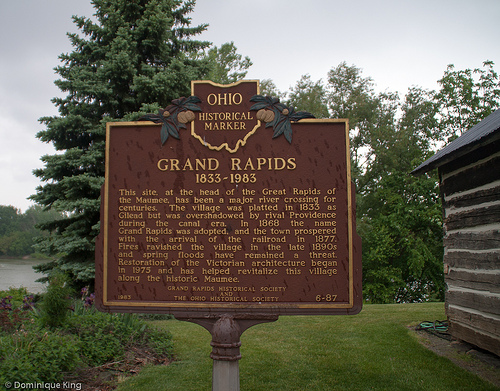
The Howard family had friends among the native Ottawa tribe in the area.
In 1835, the U.S. government moved most of the area's Ottawa Indian residents further west.
One of the tribe's members, Tee-na-Beek, remained in Grand Rapids. His widow had nowhere to bury him when he died in 1850, so Thomas Howard's grandson Dresden offered space in the cemetery near the Howards for Tee-na-Beek's final resting place.
They buried Tee-na-Beek's body, wrapped in a beautiful blanket, in the cemetery where the head stone informs visitors that he was "the last Indian (Ottawa) of the Maumee Valley".

A nearby historical marker says that Thomas Howard was the first burial at this cemetery on a sharp bluff in 1825. In 1938, WPA workers leveled the ground and moved most of the graves, leaving behind the small Howard family plot and the grave of Dresden's friend, Tee-na-Beek.
The graves are on a busy corner near a gas station at the intersection of Front Street and Wapakoneta Road.
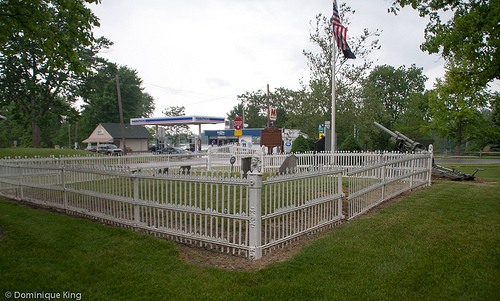
Travelers could easily ford the Maumee River here much of the year, and the community became part of an Underground Railroad route north.
Dresden and his parents were active in the Underground Railroad housing, feeding and guiding runaway slaves past a notorious slave catcher in the area. The Howards were active in this effort as early as 1816 and often worked in concert with the area's Indians to move the freedom seekers through the area and on to Malden, Canada.
By 1868, the village of Gilead gained the "more sophisticated name" of Grand Rapids.
Grand Rapids became a commercial hub for the area with the arrival of the railroad during the 1870s.
Today, traces of the town's nineteenth-century history remain like the Howard Cemetery, a log cabin operating as a tourist welcome center, and a number of Victorian-style homes and commercial buildings downtown (including an old steam-powered mill built around the turn-of-the-century that now serves as a bed-and-breakfast inn).
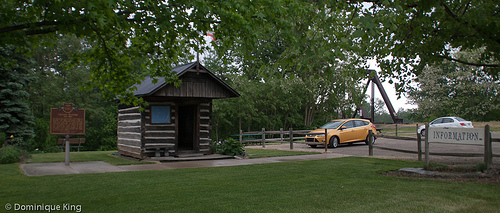
Our stay at Grand Rapids was short as the rain picked up again and we headed home, but we're excited about the idea of returning to explore and find out more about this historic canal town.
Want to learn more about the history of Ohio's canals? Check out A Photo Album of Ohio's Canal Era: 1825-1913 by Jack Gleck or Canals of Ohio: A History and Tour Guide by Boone Triplett.
© Dominique King 2013 All rights reserved
Posted at 03:00 AM in History, Ohio, Toledo, Travel | Permalink | Comments (0) | TrackBack (0)
|
| |
November 07, 2013
Grand Marais Lighthouse near Michigan's Pictured Rocks National Lakeshore
The Ojibwa Indians called Grand Marais Kitchi-bitobig, which meant ("great pond"). The name seemed to make some sense as the community sits on Lake Superior's south shore.
French explorers and traders arrived as early as 1619 and supposedly dubbed the area Grand Marais, which meant "great marsh", even though there is no marsh in the area. There is debate as to whether the name is a mistake in perception or a cartographer's mistake, but the name stuck.
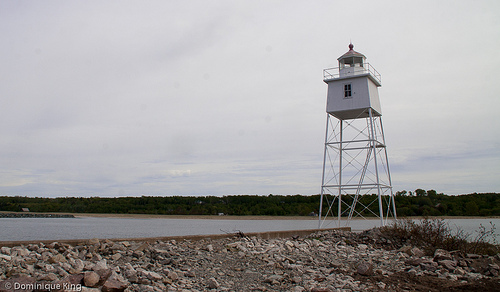
The first permanent European settler arrived in 1861 when Peter Barbeau established a trading post here.
Increased maritime traffic at Grand Marais from trapping and the lumbering industry led to Federal approval for the Army Corp of Engineers to start a major harbor improvement project in 1881 to build and deepen a channel for commercial traffic and to create a harbor of refuge at Grand Marais.
Work continued over the next decade as the Army Corps built a 5,770-foot timber pier across the bay to a dredged channel on the western shore. By the end of the 1880s, and after spending more than $250,000, two protective piers flanked a channel dredged to 40 feet deep.
Most of the lumber at Grand Marais was gone by 1884. The town's lumber mill closed, population declined, and the remaining residents turned to fishing to support themselves.
Maritime traffic remained relatively strong, especially after the Manistique Railroad came to Grand Marais, making it easier to transport lumber from forests in the region to the port for shipping elsewhere. The mill reopened after enlarging and expanding.
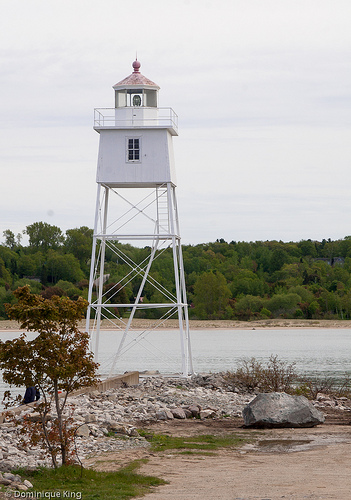
Congress appropriated $15,000 to place a light tower and fog bell at Grand Marias in 1895.
The fog bell and mechanism came from nearby Point Iroquois lighthouse, as the station there upgraded to a steam -whistle system. The Grand Marais light with its Fresnel lens sat atop a 34-foot-tall tower on a skeletal frame bolted to the pier.
Using the old Point Iroquois fog bell and the lack of a keepers' dwelling at Grand Marias helped the project come in under budge, so Congress approved a request to use the extra money for a rear range light at Grand Marais.
Construction of a life-saving station at Grand Marais gained approval in 1898.
Money came through to extend the west pier an additional 612 feet and to move the lighthouse further out on the pier in 1904.

In 1908, Congress appropriated $5,000 to build a keeper's dwelling at Grand Marias after repeated requests from the Lighthouse Board. The keepers previously lived in a shamefully shabby shanty on the pier constructed from scrap materials by the first lighthouse keeper.
Maritime traffic at Grand Marais experienced a steep decline as lumbering and commercial fishing declined from the 1910s on. While it remained the only harbor of refuge between Marquette and Sault St. Marie, the commercial importance of Grand Marais also declined after the construction of the MacArthur Lock at Sault St. Marie.

The Coast Guard took over the life-saving station in 1938, and they took over light keeping duties during World War II.
The Army Corps of Engineers quit maintaining the breakwater at Grand Marias during the 1940s, and harbor filled with sand as the wooden breakwater deteriorated. The harbor became much shallower, allowing only smaller vessels to enter the harbor with ease.
The Coast Guard deactivated their Grand Marais station in 1981.The National Park Service now owns it and uses it as a ranger station for the Pictured Rocks National Lakeshore.
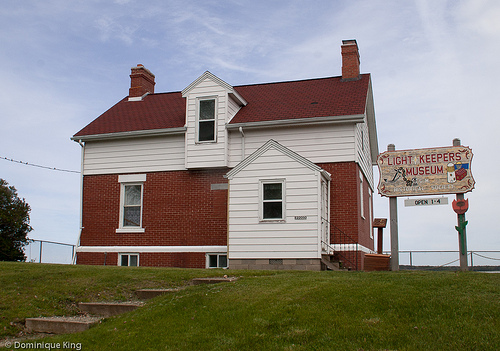
The Grand Marais Historical Society acquired the light keepers' dwelling in 1984, restored it and now operates it as a museum during the summer.
Today maritime traffic at Grand Marais primarily consists of pleasure boats. Tourists visiting the Pictured Rocks National Lakeshore often visit town and the harbor reportedly draws many fishers in spring and fall for the plentiful Coho, steelhead and whitefish caught here.
We dropped by the harbor on a quiet week day in early June to see the front range light on the pier and the light keepers' dwelling.
We had no company beyond a lone fisher sitting on the pier near the lighthouse. The museum wasn't open because of budget cutbacks delaying many recreational and park site openings this season.
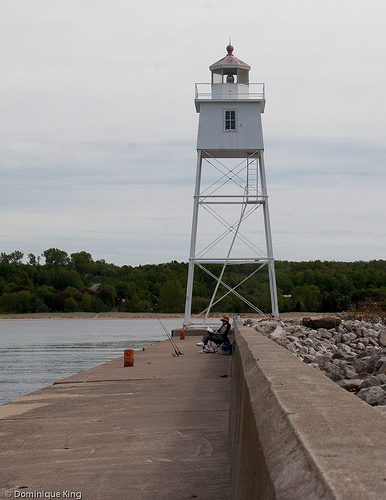
It is visiting on dreary days like this, though, that can give you a little sense of just how isolated this harbor can be.
Want to learn more about Grand Marais and its maritime history? Check out Grand Marais (Images of America) by the Grand Marais Historical Society or Lake Superior's Shipwreck Coast: A Survey of Maritime Accidents from Whitefish Bay's Point Iroquois to Grand Marais, Michigan by Frederick Stonehouse.
© Dominique King 2013 All rights reserved
Posted at 03:00 AM in Lighthouse, Michigan, Travel | Permalink | Comments (2) | TrackBack (0)
|
| |
November 05, 2013
Midwest travel links for October 2013
Check out some great Midwest-related stories I found online this past month:
A Galena Getaway-Visiting Galena, Illinois has been on my Midwest bucket list ever since I first read about the town with its quaint bed-and-breakfast inns, shops and historic buildings many years ago. Rosalind's story at Farsighted Fly Girl about a recent visit to President Grant's hometown to celebrate her anniversary reminded me why I've always wanted to see it for myself.
Haunted DeSoto House Hotel, Galena IL-Connie also visited Galena recently and shared her experience at the supposedly spooky DeSoto House Hotel there on her Midwest Wanderer blog.
Visiting Kaskaskia Island: Illinois' Island that can only be reached from Missouri-Kaskaskia was once the capitol of the Illinois Territory, but the island only appeared around 1881 when the Mississippi River carved a piece of Kaskaskia off from the mainland to create an island. Becky gives readers a glimpse of this unique southern Illinois community at the Family Rambling blog.
Surprises you'll find while looking for Lincoln-Sheila takes readers of the Perceptive Travel blog to Springfield, Illinois, home to the Abraham Lincoln Presidential Library and Museum and where our 16th president spent many years of the early years of his marriage and political career.
Lincoln Highway Dedicated 100 years ago tonight!-The history of the Lincoln Highway fascinates me, and I liked this account of the decision to officially dedicate the country's first trans-continental highway on Halloween. Check it out at Lincoln Highway News.

Spooky Geocaching in Hendricks County- Cemetery geocaches are among our favorite caches to seek because of the interesting local history we often learn during the search. Amanda shares a listing of caches in cemeteries and other reportedly haunted places on Indiana's Hendricks County All Access blog.
Board a Tram and Travel Past Stones, Lions and a Mermaid at Cincinnati's Spring Grove Cemetery-Betsy takes readers on a grand tour of a Cincinnati, Ohio cemetery with many sculptures and other artwork memorializing the Ohio city's leading citizens throughout the years at the beesfirstappearance blog. This cemetery reminds me a bit of Cleveland, Ohio's Lake View Cemetery with its great headstones and statues.
Friday Favorites: "Hidden Gems"-Lisa likens Indiana's State Library building to "an ornate treasure box" full of beautiful craftsmanship, art, history and literature. The photos of the older section of the building completed and dedicated in late 1934 belie its Depression-era origins and remind me of older Beaux Arts-style buildings of the early 20th century with just a touch of Art Deco style. Check it out at the Historic Indianapolis blog.
Statues, Sand and Studebakers: Eight of the Coolest Places in Indiana-Scott's list of must-sees in Indiana includes a few I've visited, like the Basilica of the Sacred Heart at South Bend and the collection of life-sized and life-like statues in Carmel. He also takes readers to a few more sites that I'd love to see, like Michael Jackson's birthplace in Gary and the Studebaker National Museum in South Bend. Check the list out at the Quirky Travel Guy blog.
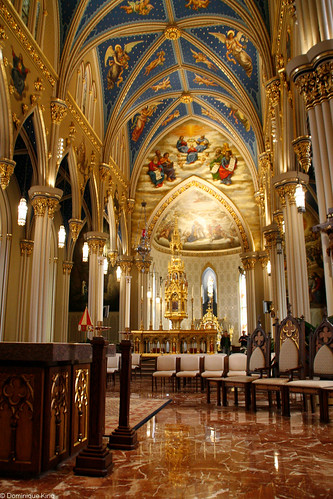
Native American Art in Owen Park-You often find art in the most unlikely places, and Charlie discovers an interesting and intriguing gem of Native-style art in a little known park on Detroit's riverfront. Charlie tells this story at his Bikes, Books & A Little Music blog.
Review: Cleveland Botanical Gardens with Kids-We've parked in the Cleveland Botanical Gardens parking garage when visiting the nearby Cleveland Museum of Art, but we've yet to visit the gardens. I appreciated Justin's tour of the botanical gardens at his InACents blog.
Underground Railroad becomes reality in Lewis, Iowa-I was surprised to learn that there were several Underground Railroad stops in Iowa and Nebraska. Read Lisa and Tim's story on The Walking Tourists blog about the Hitchcock House in Lewis, Iowa where Congregationalist pastor George Hitchcock lived for a dozen years and helped runaway slaves on their journey to freedom.
That's it for this month's Midwest travel links list. Do you have any favorite Midwest stories or blogs to share?
Want more Midwest news and links? Subscribe to my bi-monthly Midwest Guest newsletter!
© Dominique King 2013 All rights reserved
Posted at 03:00 AM in Detroit, geocaching, Illinois, Indiana, Iowa, Michigan, Missouri, Ohio, Travel | Permalink | Comments (3) | TrackBack (0)
|
| |

